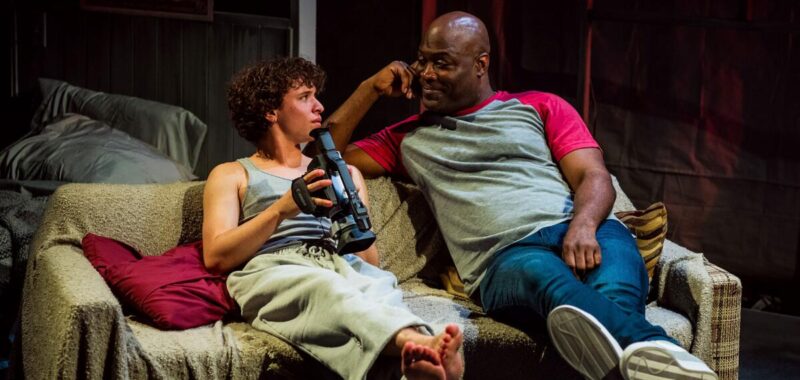The first thing you notice about the set for “Monsters of the American Cinema,” a recent play by Christian St. Croix that’s having its Los Angeles premiere at the Matrix Theatre in a Rogue Machine production, is the glow of black and white horror films.
Lighting designer Ric Zimmerman has captured to perfection that cozy hue when you’re curled up in a blanket on the couch engrossed in an old movie that’s doing its best to scare you to death. But in this case, the otherworldly glare is more prominent than usual because Remy (Kevin Daniels) and “Pup” (Logan Leonardo Arditty) live in a motor home on the lot of the Good Time Drive-In in Santee, Calif.
This is the family business of a nontraditional family. Remy was married to Pup’s father, the owner of the cinema who lost his life to drug addiction. Pup is still in high school, and Remy, a Black gay man with an outsize personality, is raising him while managing the drive-in.
“Talk to Oprah,” Remy says to Pup, who’s nervous that his date for homecoming is going to expect him to dance. Normal adolescent stuff, except life in this household has been anything but normal.
Images of Frankenstein’s monster, the Werewolf and the Creature from the Black Lagoon wreaking destruction flicker in the background. But even more terrifying are reports of everyday horror — a gay bashing in the gay-friendly part of San Diego, an episode of cruel LGBTQ+ bullying at the high school, the treacherous specter of drug abuse and the inexorable phantom of death.
To contend with the weight of their grief and trauma, Remy and Pup find escape in American horror classics. They’re both walking encyclopedias of the genre, able to reel off titles of films, popular and obscure, with the alacrity of true aficionados.
“Monsters of the American Cinema” unfolds in part through tandem monologues. Remy and Pup take turns filling the audience in on their backstory. The nature of their relationship is perhaps the sweetest element of the play. Remy is learning on the fly how to be a caretaker while Pup is figuring out through trial and error how to let someone look after him. They both have been burned by betrayal and loss, so trust is hard to come by. But they keep loving anyway.
St. Croix has written these characters with unflinching honesty. There’s grit in his depiction of their battered lives and capacious empathy in the way he honors their impressive resilience. These qualities are magnified in Rogue Machine’s production, directed with exquisite sensitivity by founding artistic director John Perrin Flynn.
The unorthodox domestic arrangement and horror movie dimension of “Monsters of the American Cinema” are adroitly realized in the snug scenic design by Stephanie Kerley Schwartz, the eerie soundscape by Christopher Moscatiello, the invigorating graphic and projection design of Michelle Hanzelova-Bierbauer and the haunting quality of Zimmerman’s lighting. But the play’s dramatic engine isn’t as well developed as the general situation of the characters or the resonant monster movie metaphor.
The duologues do perhaps too much of the play’s work. Not enough of the core material is dramatized. The playwright occasionally preempts the audience’s discovery with direct address explanation.
In his portrayal of Remy, Daniels nicely draws out the paternal fretfulness of an accidental dad. He fully inhabits the range of feelings of his character, who is still navigating his way through his bereavement. If the performance could use a bit more restraint in critical moments, it’s only to allow the audience the opportunity to connect the character’s interior dots without coaching.
Arditty brings an adolescent innocence that is as tumultuous as it is refreshing. There’s something unpredictable and even a touch dangerous about his Pup. The sorrow and anger repressed within him are as fearsome as the cinematic zombies, ghouls and homicidal maniacs that have seized his imagination.
St. Croix allows “Monsters of the American Cinema” to take a surreal turn, where dreams, reality and the movies blur into a coherent psychological story. The plot leaves a jumpy impression (the storytelling hasn’t yet settled into an assured rhythm), but the playwriting freedom is exhilarating.
As their performances grow in scale to match the black-and-white scenes of terror projected onto the stage, Daniels and Arditty ground these heightened moments in complicated family truth. They not only confront the monsters that have been stalking them, but together they find ways to coexist safely with what they fear most.

